A Comprehensive Analysis of Policy Making and Climate Change: UNFCCC
VerifiedAdded on 2021/04/21
|18
|4994
|258
Essay
AI Summary
This essay provides a detailed analysis of policy making and climate change, focusing on the United Nations Framework Convention on Climate Change (UNFCCC). It examines the objectives and principles of the convention, highlighting the global impact of climate change and the need for stabilization of greenhouse gas concentrations. The essay delves into the issues addressed by the UNFCCC, including sea level rise, temperature increases, and the impact on various ecosystems and regions. It further analyzes the policy instruments, such as the Kyoto Protocol, used to address climate change, and the role of the Conference of Parties and the Secretariat in coordinating actions. The essay underscores the importance of equity, the deterrent principle, and the integration of climate change policies with national development programs. It also discusses the adverse impacts of climate change on various regions, including the Arctic, Africa, and the Pacific Islands. This essay provides a comprehensive overview of the UNFCCC's role in addressing climate change, its objectives, principles, and the various legal instruments and processes involved.
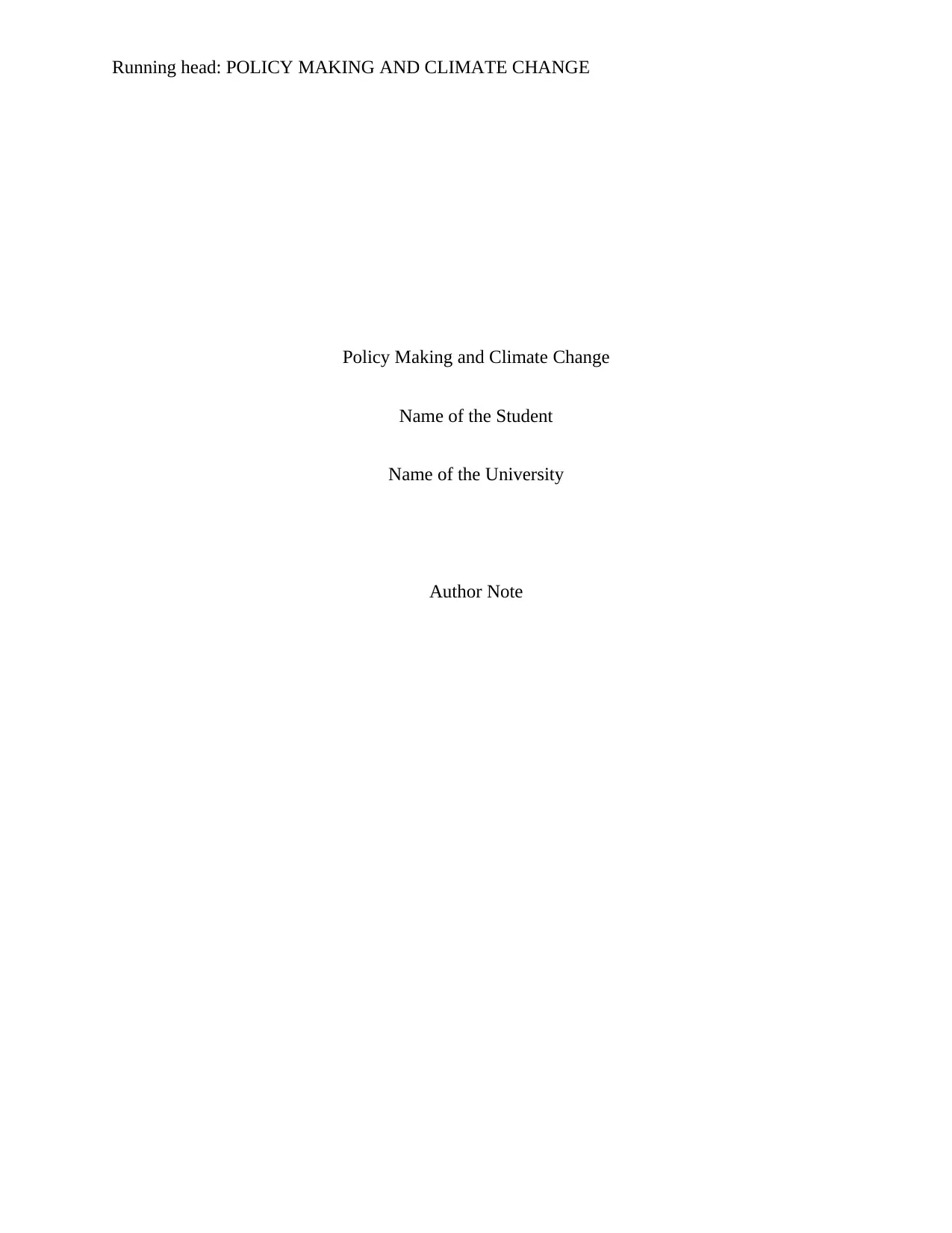
Running head: POLICY MAKING AND CLIMATE CHANGE
Policy Making and Climate Change
Name of the Student
Name of the University
Author Note
Policy Making and Climate Change
Name of the Student
Name of the University
Author Note
Paraphrase This Document
Need a fresh take? Get an instant paraphrase of this document with our AI Paraphraser
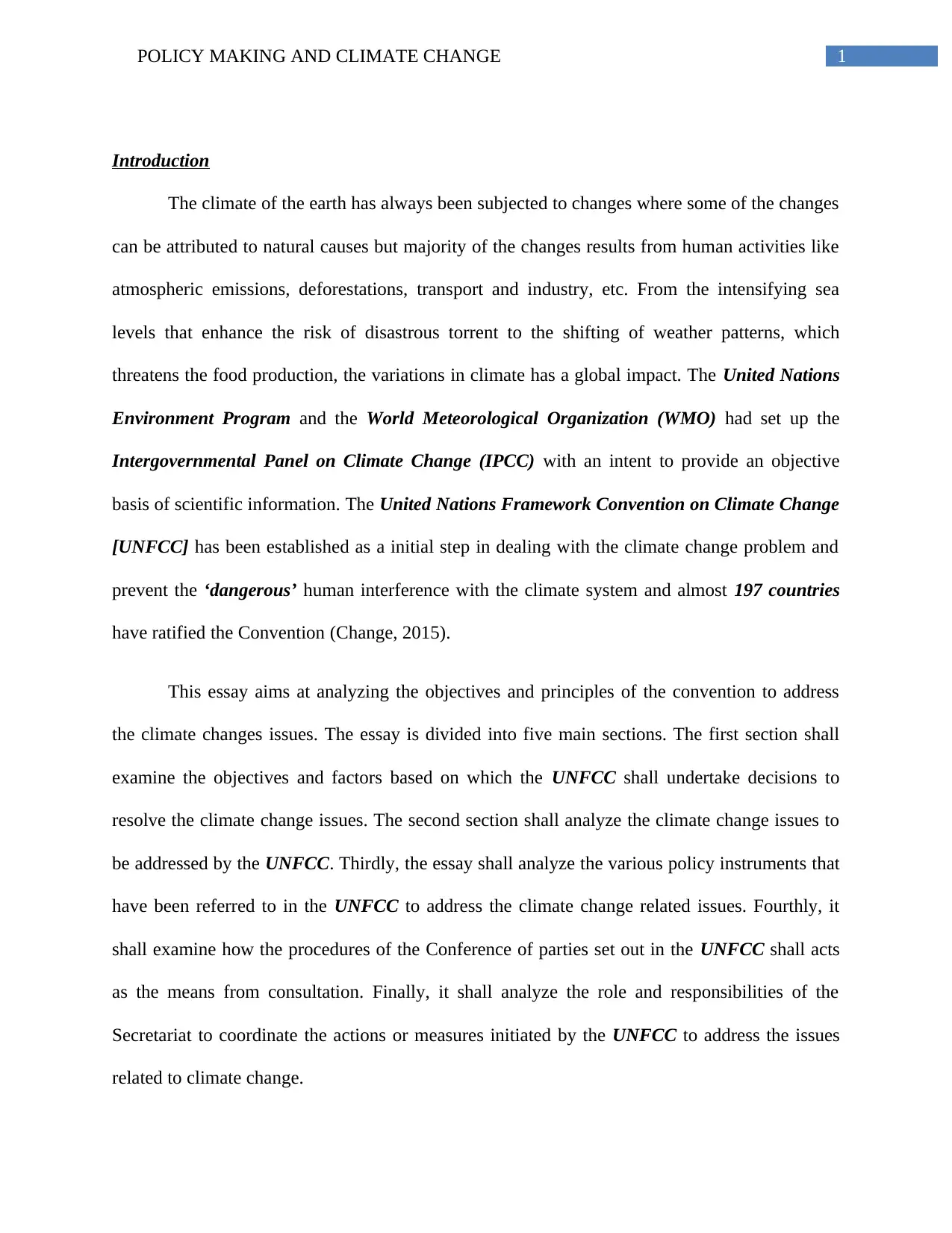
1POLICY MAKING AND CLIMATE CHANGE
Introduction
The climate of the earth has always been subjected to changes where some of the changes
can be attributed to natural causes but majority of the changes results from human activities like
atmospheric emissions, deforestations, transport and industry, etc. From the intensifying sea
levels that enhance the risk of disastrous torrent to the shifting of weather patterns, which
threatens the food production, the variations in climate has a global impact. The United Nations
Environment Program and the World Meteorological Organization (WMO) had set up the
Intergovernmental Panel on Climate Change (IPCC) with an intent to provide an objective
basis of scientific information. The United Nations Framework Convention on Climate Change
[UNFCC] has been established as a initial step in dealing with the climate change problem and
prevent the ‘dangerous’ human interference with the climate system and almost 197 countries
have ratified the Convention (Change, 2015).
This essay aims at analyzing the objectives and principles of the convention to address
the climate changes issues. The essay is divided into five main sections. The first section shall
examine the objectives and factors based on which the UNFCC shall undertake decisions to
resolve the climate change issues. The second section shall analyze the climate change issues to
be addressed by the UNFCC. Thirdly, the essay shall analyze the various policy instruments that
have been referred to in the UNFCC to address the climate change related issues. Fourthly, it
shall examine how the procedures of the Conference of parties set out in the UNFCC shall acts
as the means from consultation. Finally, it shall analyze the role and responsibilities of the
Secretariat to coordinate the actions or measures initiated by the UNFCC to address the issues
related to climate change.
Introduction
The climate of the earth has always been subjected to changes where some of the changes
can be attributed to natural causes but majority of the changes results from human activities like
atmospheric emissions, deforestations, transport and industry, etc. From the intensifying sea
levels that enhance the risk of disastrous torrent to the shifting of weather patterns, which
threatens the food production, the variations in climate has a global impact. The United Nations
Environment Program and the World Meteorological Organization (WMO) had set up the
Intergovernmental Panel on Climate Change (IPCC) with an intent to provide an objective
basis of scientific information. The United Nations Framework Convention on Climate Change
[UNFCC] has been established as a initial step in dealing with the climate change problem and
prevent the ‘dangerous’ human interference with the climate system and almost 197 countries
have ratified the Convention (Change, 2015).
This essay aims at analyzing the objectives and principles of the convention to address
the climate changes issues. The essay is divided into five main sections. The first section shall
examine the objectives and factors based on which the UNFCC shall undertake decisions to
resolve the climate change issues. The second section shall analyze the climate change issues to
be addressed by the UNFCC. Thirdly, the essay shall analyze the various policy instruments that
have been referred to in the UNFCC to address the climate change related issues. Fourthly, it
shall examine how the procedures of the Conference of parties set out in the UNFCC shall acts
as the means from consultation. Finally, it shall analyze the role and responsibilities of the
Secretariat to coordinate the actions or measures initiated by the UNFCC to address the issues
related to climate change.
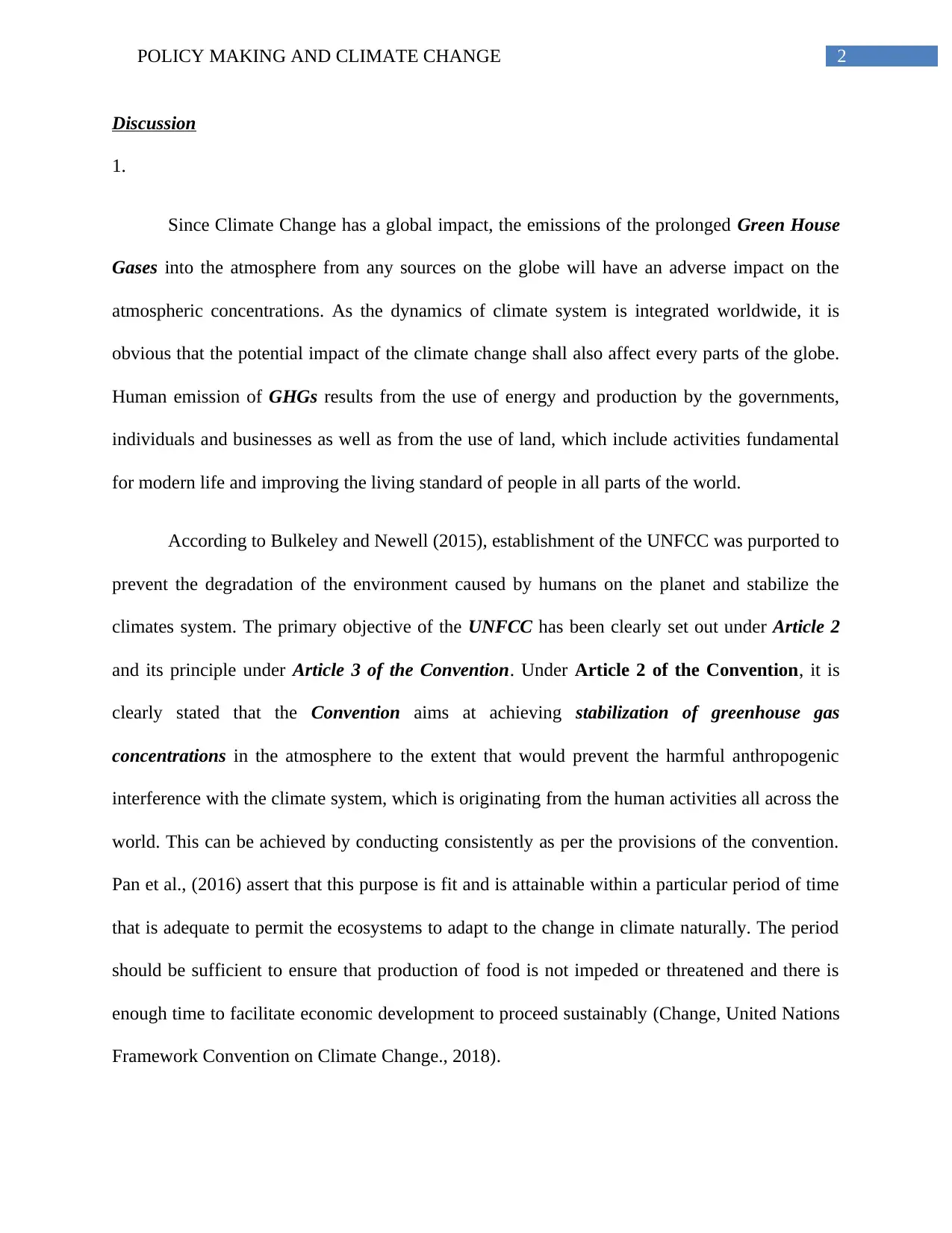
2POLICY MAKING AND CLIMATE CHANGE
Discussion
1.
Since Climate Change has a global impact, the emissions of the prolonged Green House
Gases into the atmosphere from any sources on the globe will have an adverse impact on the
atmospheric concentrations. As the dynamics of climate system is integrated worldwide, it is
obvious that the potential impact of the climate change shall also affect every parts of the globe.
Human emission of GHGs results from the use of energy and production by the governments,
individuals and businesses as well as from the use of land, which include activities fundamental
for modern life and improving the living standard of people in all parts of the world.
According to Bulkeley and Newell (2015), establishment of the UNFCC was purported to
prevent the degradation of the environment caused by humans on the planet and stabilize the
climates system. The primary objective of the UNFCC has been clearly set out under Article 2
and its principle under Article 3 of the Convention. Under Article 2 of the Convention, it is
clearly stated that the Convention aims at achieving stabilization of greenhouse gas
concentrations in the atmosphere to the extent that would prevent the harmful anthropogenic
interference with the climate system, which is originating from the human activities all across the
world. This can be achieved by conducting consistently as per the provisions of the convention.
Pan et al., (2016) assert that this purpose is fit and is attainable within a particular period of time
that is adequate to permit the ecosystems to adapt to the change in climate naturally. The period
should be sufficient to ensure that production of food is not impeded or threatened and there is
enough time to facilitate economic development to proceed sustainably (Change, United Nations
Framework Convention on Climate Change., 2018).
Discussion
1.
Since Climate Change has a global impact, the emissions of the prolonged Green House
Gases into the atmosphere from any sources on the globe will have an adverse impact on the
atmospheric concentrations. As the dynamics of climate system is integrated worldwide, it is
obvious that the potential impact of the climate change shall also affect every parts of the globe.
Human emission of GHGs results from the use of energy and production by the governments,
individuals and businesses as well as from the use of land, which include activities fundamental
for modern life and improving the living standard of people in all parts of the world.
According to Bulkeley and Newell (2015), establishment of the UNFCC was purported to
prevent the degradation of the environment caused by humans on the planet and stabilize the
climates system. The primary objective of the UNFCC has been clearly set out under Article 2
and its principle under Article 3 of the Convention. Under Article 2 of the Convention, it is
clearly stated that the Convention aims at achieving stabilization of greenhouse gas
concentrations in the atmosphere to the extent that would prevent the harmful anthropogenic
interference with the climate system, which is originating from the human activities all across the
world. This can be achieved by conducting consistently as per the provisions of the convention.
Pan et al., (2016) assert that this purpose is fit and is attainable within a particular period of time
that is adequate to permit the ecosystems to adapt to the change in climate naturally. The period
should be sufficient to ensure that production of food is not impeded or threatened and there is
enough time to facilitate economic development to proceed sustainably (Change, United Nations
Framework Convention on Climate Change., 2018).
⊘ This is a preview!⊘
Do you want full access?
Subscribe today to unlock all pages.

Trusted by 1+ million students worldwide
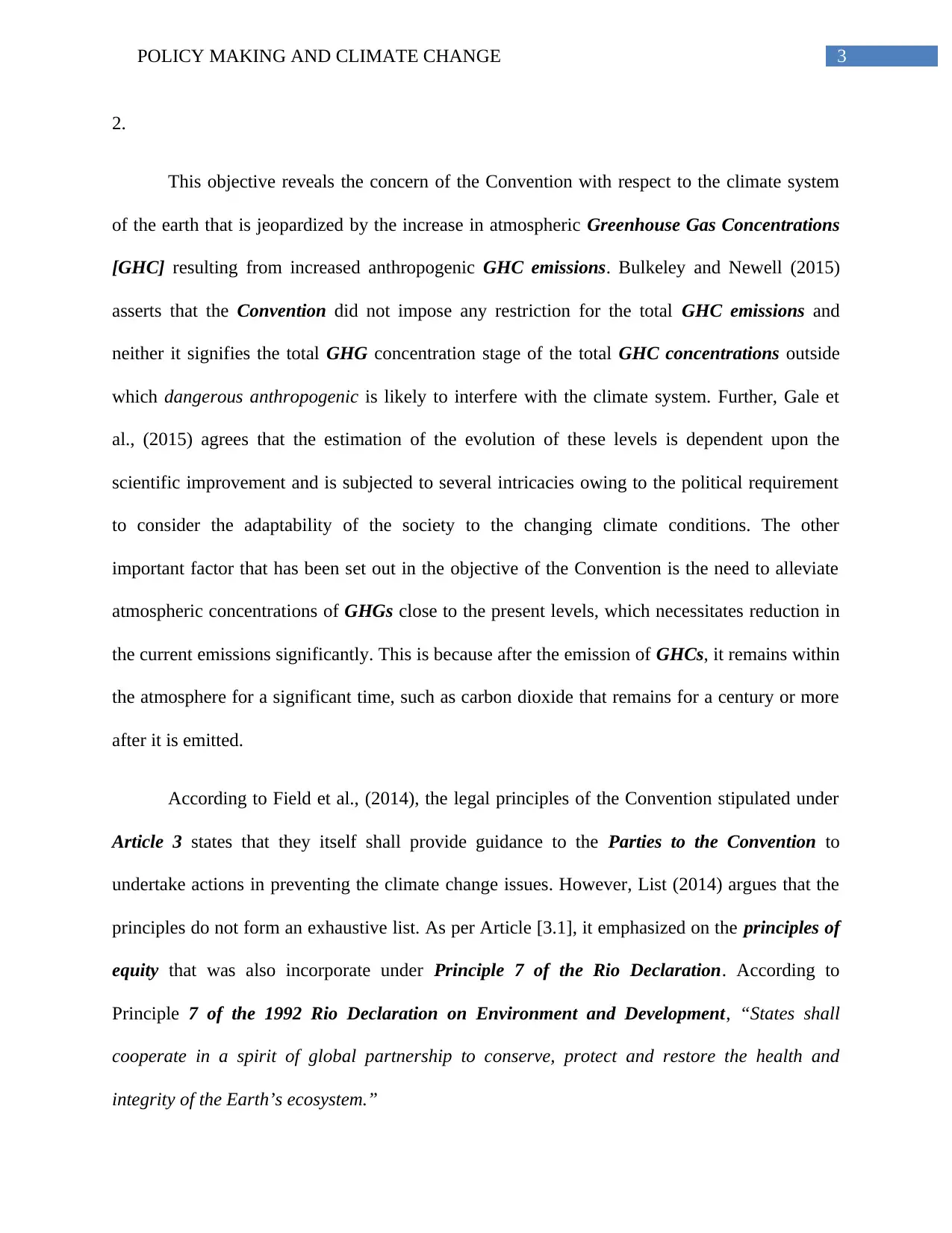
3POLICY MAKING AND CLIMATE CHANGE
2.
This objective reveals the concern of the Convention with respect to the climate system
of the earth that is jeopardized by the increase in atmospheric Greenhouse Gas Concentrations
[GHC] resulting from increased anthropogenic GHC emissions. Bulkeley and Newell (2015)
asserts that the Convention did not impose any restriction for the total GHC emissions and
neither it signifies the total GHG concentration stage of the total GHC concentrations outside
which dangerous anthropogenic is likely to interfere with the climate system. Further, Gale et
al., (2015) agrees that the estimation of the evolution of these levels is dependent upon the
scientific improvement and is subjected to several intricacies owing to the political requirement
to consider the adaptability of the society to the changing climate conditions. The other
important factor that has been set out in the objective of the Convention is the need to alleviate
atmospheric concentrations of GHGs close to the present levels, which necessitates reduction in
the current emissions significantly. This is because after the emission of GHCs, it remains within
the atmosphere for a significant time, such as carbon dioxide that remains for a century or more
after it is emitted.
According to Field et al., (2014), the legal principles of the Convention stipulated under
Article 3 states that they itself shall provide guidance to the Parties to the Convention to
undertake actions in preventing the climate change issues. However, List (2014) argues that the
principles do not form an exhaustive list. As per Article [3.1], it emphasized on the principles of
equity that was also incorporate under Principle 7 of the Rio Declaration. According to
Principle 7 of the 1992 Rio Declaration on Environment and Development, “States shall
cooperate in a spirit of global partnership to conserve, protect and restore the health and
integrity of the Earth’s ecosystem.”
2.
This objective reveals the concern of the Convention with respect to the climate system
of the earth that is jeopardized by the increase in atmospheric Greenhouse Gas Concentrations
[GHC] resulting from increased anthropogenic GHC emissions. Bulkeley and Newell (2015)
asserts that the Convention did not impose any restriction for the total GHC emissions and
neither it signifies the total GHG concentration stage of the total GHC concentrations outside
which dangerous anthropogenic is likely to interfere with the climate system. Further, Gale et
al., (2015) agrees that the estimation of the evolution of these levels is dependent upon the
scientific improvement and is subjected to several intricacies owing to the political requirement
to consider the adaptability of the society to the changing climate conditions. The other
important factor that has been set out in the objective of the Convention is the need to alleviate
atmospheric concentrations of GHGs close to the present levels, which necessitates reduction in
the current emissions significantly. This is because after the emission of GHCs, it remains within
the atmosphere for a significant time, such as carbon dioxide that remains for a century or more
after it is emitted.
According to Field et al., (2014), the legal principles of the Convention stipulated under
Article 3 states that they itself shall provide guidance to the Parties to the Convention to
undertake actions in preventing the climate change issues. However, List (2014) argues that the
principles do not form an exhaustive list. As per Article [3.1], it emphasized on the principles of
equity that was also incorporate under Principle 7 of the Rio Declaration. According to
Principle 7 of the 1992 Rio Declaration on Environment and Development, “States shall
cooperate in a spirit of global partnership to conserve, protect and restore the health and
integrity of the Earth’s ecosystem.”
Paraphrase This Document
Need a fresh take? Get an instant paraphrase of this document with our AI Paraphraser
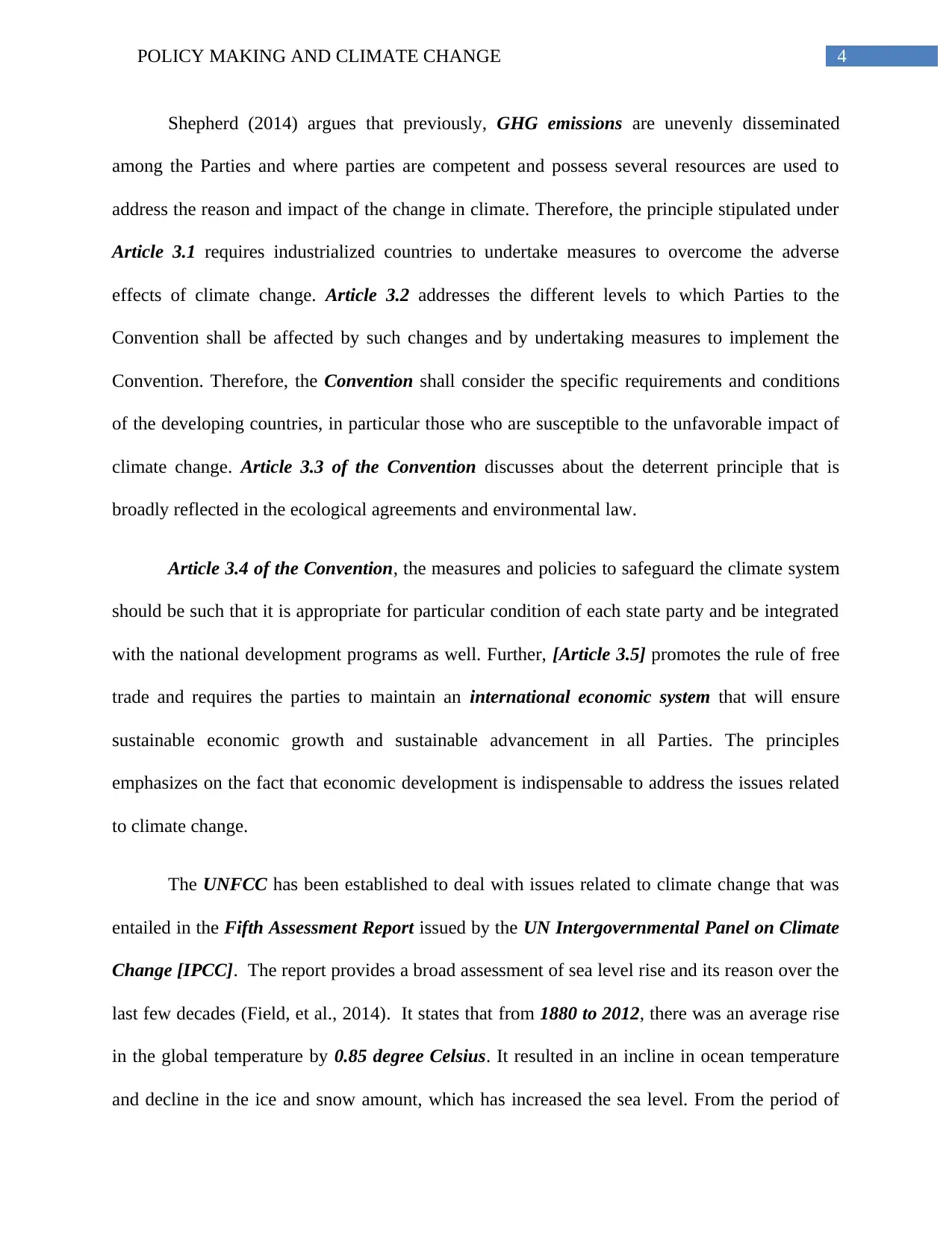
4POLICY MAKING AND CLIMATE CHANGE
Shepherd (2014) argues that previously, GHG emissions are unevenly disseminated
among the Parties and where parties are competent and possess several resources are used to
address the reason and impact of the change in climate. Therefore, the principle stipulated under
Article 3.1 requires industrialized countries to undertake measures to overcome the adverse
effects of climate change. Article 3.2 addresses the different levels to which Parties to the
Convention shall be affected by such changes and by undertaking measures to implement the
Convention. Therefore, the Convention shall consider the specific requirements and conditions
of the developing countries, in particular those who are susceptible to the unfavorable impact of
climate change. Article 3.3 of the Convention discusses about the deterrent principle that is
broadly reflected in the ecological agreements and environmental law.
Article 3.4 of the Convention, the measures and policies to safeguard the climate system
should be such that it is appropriate for particular condition of each state party and be integrated
with the national development programs as well. Further, [Article 3.5] promotes the rule of free
trade and requires the parties to maintain an international economic system that will ensure
sustainable economic growth and sustainable advancement in all Parties. The principles
emphasizes on the fact that economic development is indispensable to address the issues related
to climate change.
The UNFCC has been established to deal with issues related to climate change that was
entailed in the Fifth Assessment Report issued by the UN Intergovernmental Panel on Climate
Change [IPCC]. The report provides a broad assessment of sea level rise and its reason over the
last few decades (Field, et al., 2014). It states that from 1880 to 2012, there was an average rise
in the global temperature by 0.85 degree Celsius. It resulted in an incline in ocean temperature
and decline in the ice and snow amount, which has increased the sea level. From the period of
Shepherd (2014) argues that previously, GHG emissions are unevenly disseminated
among the Parties and where parties are competent and possess several resources are used to
address the reason and impact of the change in climate. Therefore, the principle stipulated under
Article 3.1 requires industrialized countries to undertake measures to overcome the adverse
effects of climate change. Article 3.2 addresses the different levels to which Parties to the
Convention shall be affected by such changes and by undertaking measures to implement the
Convention. Therefore, the Convention shall consider the specific requirements and conditions
of the developing countries, in particular those who are susceptible to the unfavorable impact of
climate change. Article 3.3 of the Convention discusses about the deterrent principle that is
broadly reflected in the ecological agreements and environmental law.
Article 3.4 of the Convention, the measures and policies to safeguard the climate system
should be such that it is appropriate for particular condition of each state party and be integrated
with the national development programs as well. Further, [Article 3.5] promotes the rule of free
trade and requires the parties to maintain an international economic system that will ensure
sustainable economic growth and sustainable advancement in all Parties. The principles
emphasizes on the fact that economic development is indispensable to address the issues related
to climate change.
The UNFCC has been established to deal with issues related to climate change that was
entailed in the Fifth Assessment Report issued by the UN Intergovernmental Panel on Climate
Change [IPCC]. The report provides a broad assessment of sea level rise and its reason over the
last few decades (Field, et al., 2014). It states that from 1880 to 2012, there was an average rise
in the global temperature by 0.85 degree Celsius. It resulted in an incline in ocean temperature
and decline in the ice and snow amount, which has increased the sea level. From the period of
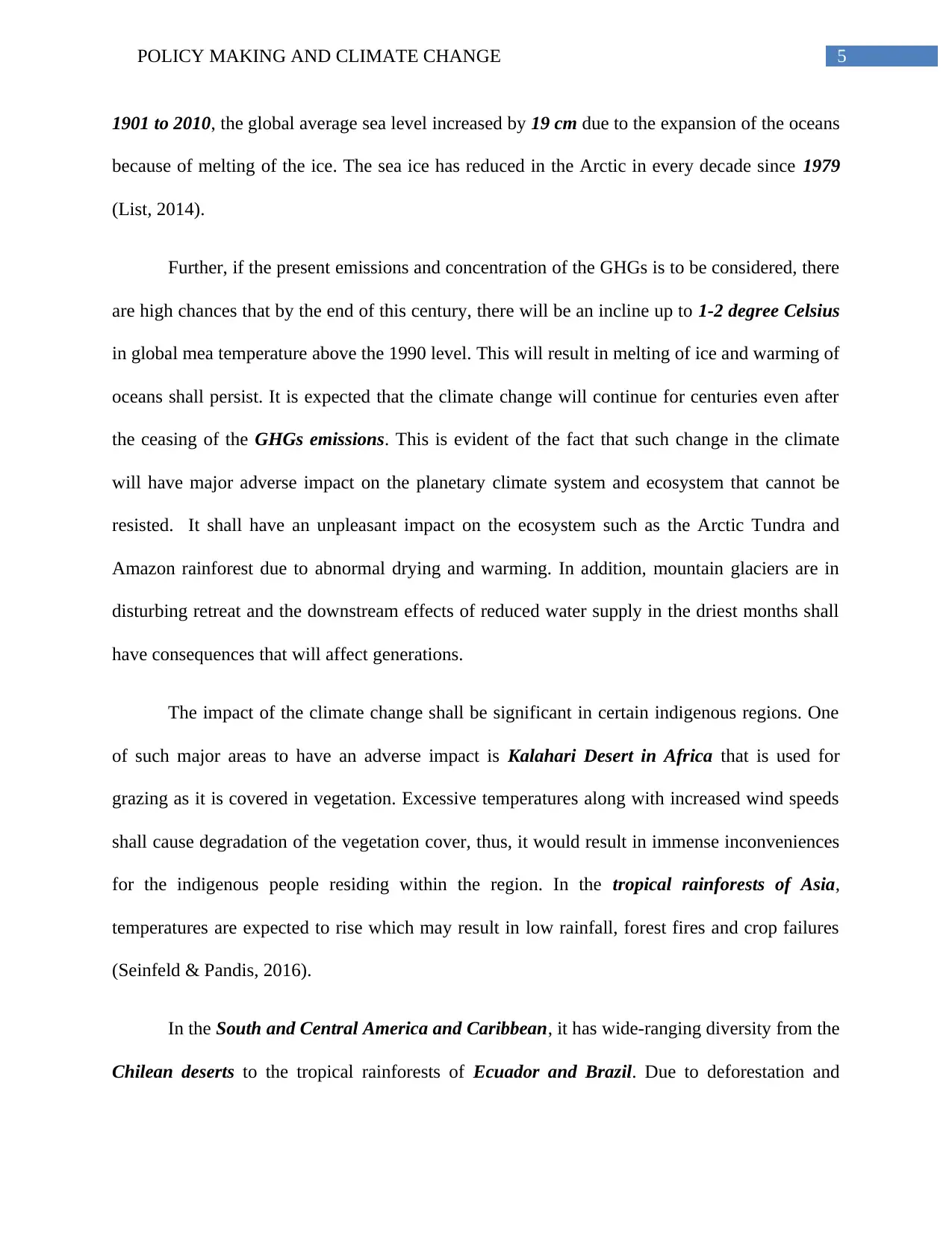
5POLICY MAKING AND CLIMATE CHANGE
1901 to 2010, the global average sea level increased by 19 cm due to the expansion of the oceans
because of melting of the ice. The sea ice has reduced in the Arctic in every decade since 1979
(List, 2014).
Further, if the present emissions and concentration of the GHGs is to be considered, there
are high chances that by the end of this century, there will be an incline up to 1-2 degree Celsius
in global mea temperature above the 1990 level. This will result in melting of ice and warming of
oceans shall persist. It is expected that the climate change will continue for centuries even after
the ceasing of the GHGs emissions. This is evident of the fact that such change in the climate
will have major adverse impact on the planetary climate system and ecosystem that cannot be
resisted. It shall have an unpleasant impact on the ecosystem such as the Arctic Tundra and
Amazon rainforest due to abnormal drying and warming. In addition, mountain glaciers are in
disturbing retreat and the downstream effects of reduced water supply in the driest months shall
have consequences that will affect generations.
The impact of the climate change shall be significant in certain indigenous regions. One
of such major areas to have an adverse impact is Kalahari Desert in Africa that is used for
grazing as it is covered in vegetation. Excessive temperatures along with increased wind speeds
shall cause degradation of the vegetation cover, thus, it would result in immense inconveniences
for the indigenous people residing within the region. In the tropical rainforests of Asia,
temperatures are expected to rise which may result in low rainfall, forest fires and crop failures
(Seinfeld & Pandis, 2016).
In the South and Central America and Caribbean, it has wide-ranging diversity from the
Chilean deserts to the tropical rainforests of Ecuador and Brazil. Due to deforestation and
1901 to 2010, the global average sea level increased by 19 cm due to the expansion of the oceans
because of melting of the ice. The sea ice has reduced in the Arctic in every decade since 1979
(List, 2014).
Further, if the present emissions and concentration of the GHGs is to be considered, there
are high chances that by the end of this century, there will be an incline up to 1-2 degree Celsius
in global mea temperature above the 1990 level. This will result in melting of ice and warming of
oceans shall persist. It is expected that the climate change will continue for centuries even after
the ceasing of the GHGs emissions. This is evident of the fact that such change in the climate
will have major adverse impact on the planetary climate system and ecosystem that cannot be
resisted. It shall have an unpleasant impact on the ecosystem such as the Arctic Tundra and
Amazon rainforest due to abnormal drying and warming. In addition, mountain glaciers are in
disturbing retreat and the downstream effects of reduced water supply in the driest months shall
have consequences that will affect generations.
The impact of the climate change shall be significant in certain indigenous regions. One
of such major areas to have an adverse impact is Kalahari Desert in Africa that is used for
grazing as it is covered in vegetation. Excessive temperatures along with increased wind speeds
shall cause degradation of the vegetation cover, thus, it would result in immense inconveniences
for the indigenous people residing within the region. In the tropical rainforests of Asia,
temperatures are expected to rise which may result in low rainfall, forest fires and crop failures
(Seinfeld & Pandis, 2016).
In the South and Central America and Caribbean, it has wide-ranging diversity from the
Chilean deserts to the tropical rainforests of Ecuador and Brazil. Due to deforestation and
⊘ This is a preview!⊘
Do you want full access?
Subscribe today to unlock all pages.

Trusted by 1+ million students worldwide
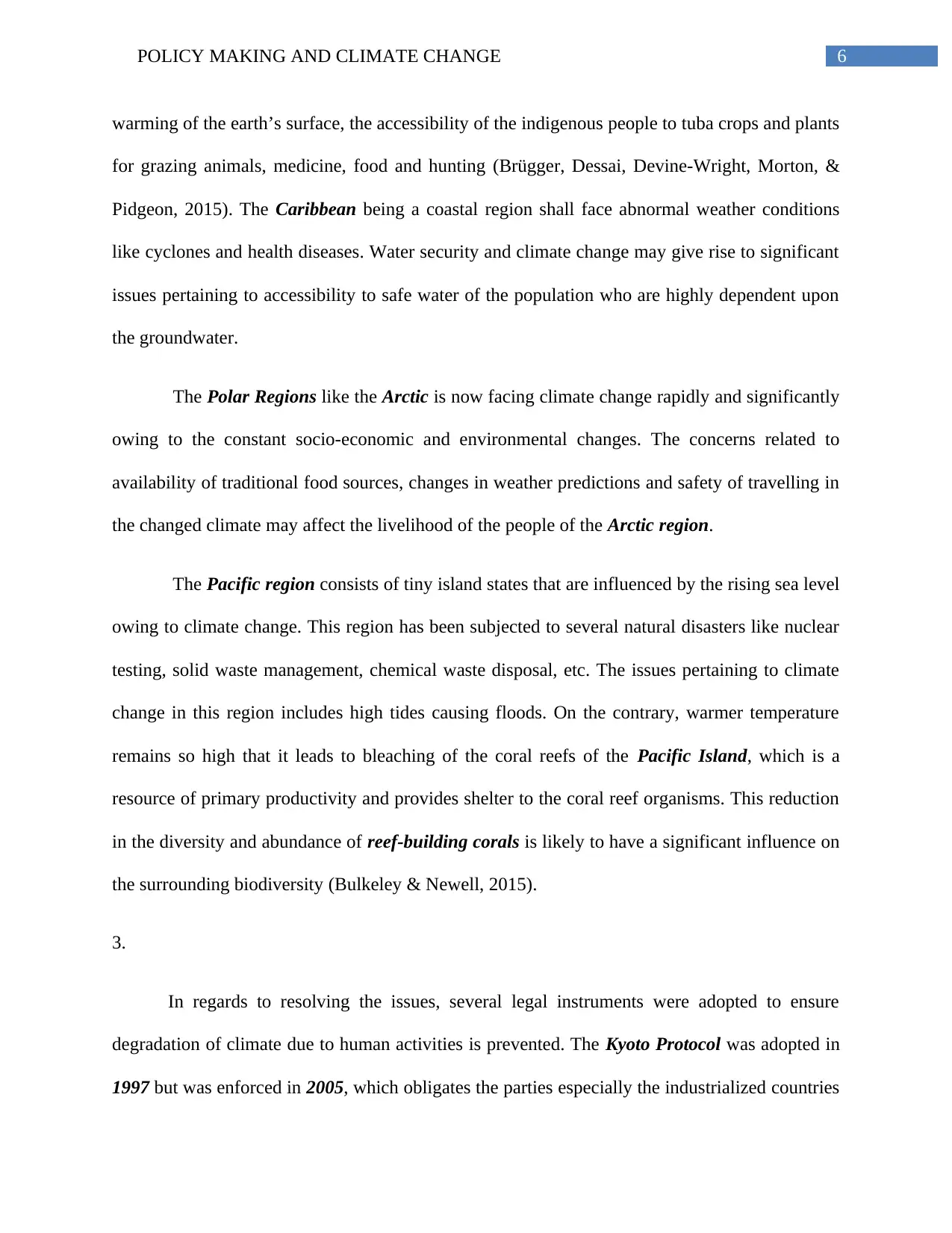
6POLICY MAKING AND CLIMATE CHANGE
warming of the earth’s surface, the accessibility of the indigenous people to tuba crops and plants
for grazing animals, medicine, food and hunting (Brügger, Dessai, Devine-Wright, Morton, &
Pidgeon, 2015). The Caribbean being a coastal region shall face abnormal weather conditions
like cyclones and health diseases. Water security and climate change may give rise to significant
issues pertaining to accessibility to safe water of the population who are highly dependent upon
the groundwater.
The Polar Regions like the Arctic is now facing climate change rapidly and significantly
owing to the constant socio-economic and environmental changes. The concerns related to
availability of traditional food sources, changes in weather predictions and safety of travelling in
the changed climate may affect the livelihood of the people of the Arctic region.
The Pacific region consists of tiny island states that are influenced by the rising sea level
owing to climate change. This region has been subjected to several natural disasters like nuclear
testing, solid waste management, chemical waste disposal, etc. The issues pertaining to climate
change in this region includes high tides causing floods. On the contrary, warmer temperature
remains so high that it leads to bleaching of the coral reefs of the Pacific Island, which is a
resource of primary productivity and provides shelter to the coral reef organisms. This reduction
in the diversity and abundance of reef-building corals is likely to have a significant influence on
the surrounding biodiversity (Bulkeley & Newell, 2015).
3.
In regards to resolving the issues, several legal instruments were adopted to ensure
degradation of climate due to human activities is prevented. The Kyoto Protocol was adopted in
1997 but was enforced in 2005, which obligates the parties especially the industrialized countries
warming of the earth’s surface, the accessibility of the indigenous people to tuba crops and plants
for grazing animals, medicine, food and hunting (Brügger, Dessai, Devine-Wright, Morton, &
Pidgeon, 2015). The Caribbean being a coastal region shall face abnormal weather conditions
like cyclones and health diseases. Water security and climate change may give rise to significant
issues pertaining to accessibility to safe water of the population who are highly dependent upon
the groundwater.
The Polar Regions like the Arctic is now facing climate change rapidly and significantly
owing to the constant socio-economic and environmental changes. The concerns related to
availability of traditional food sources, changes in weather predictions and safety of travelling in
the changed climate may affect the livelihood of the people of the Arctic region.
The Pacific region consists of tiny island states that are influenced by the rising sea level
owing to climate change. This region has been subjected to several natural disasters like nuclear
testing, solid waste management, chemical waste disposal, etc. The issues pertaining to climate
change in this region includes high tides causing floods. On the contrary, warmer temperature
remains so high that it leads to bleaching of the coral reefs of the Pacific Island, which is a
resource of primary productivity and provides shelter to the coral reef organisms. This reduction
in the diversity and abundance of reef-building corals is likely to have a significant influence on
the surrounding biodiversity (Bulkeley & Newell, 2015).
3.
In regards to resolving the issues, several legal instruments were adopted to ensure
degradation of climate due to human activities is prevented. The Kyoto Protocol was adopted in
1997 but was enforced in 2005, which obligates the parties especially the industrialized countries
Paraphrase This Document
Need a fresh take? Get an instant paraphrase of this document with our AI Paraphraser
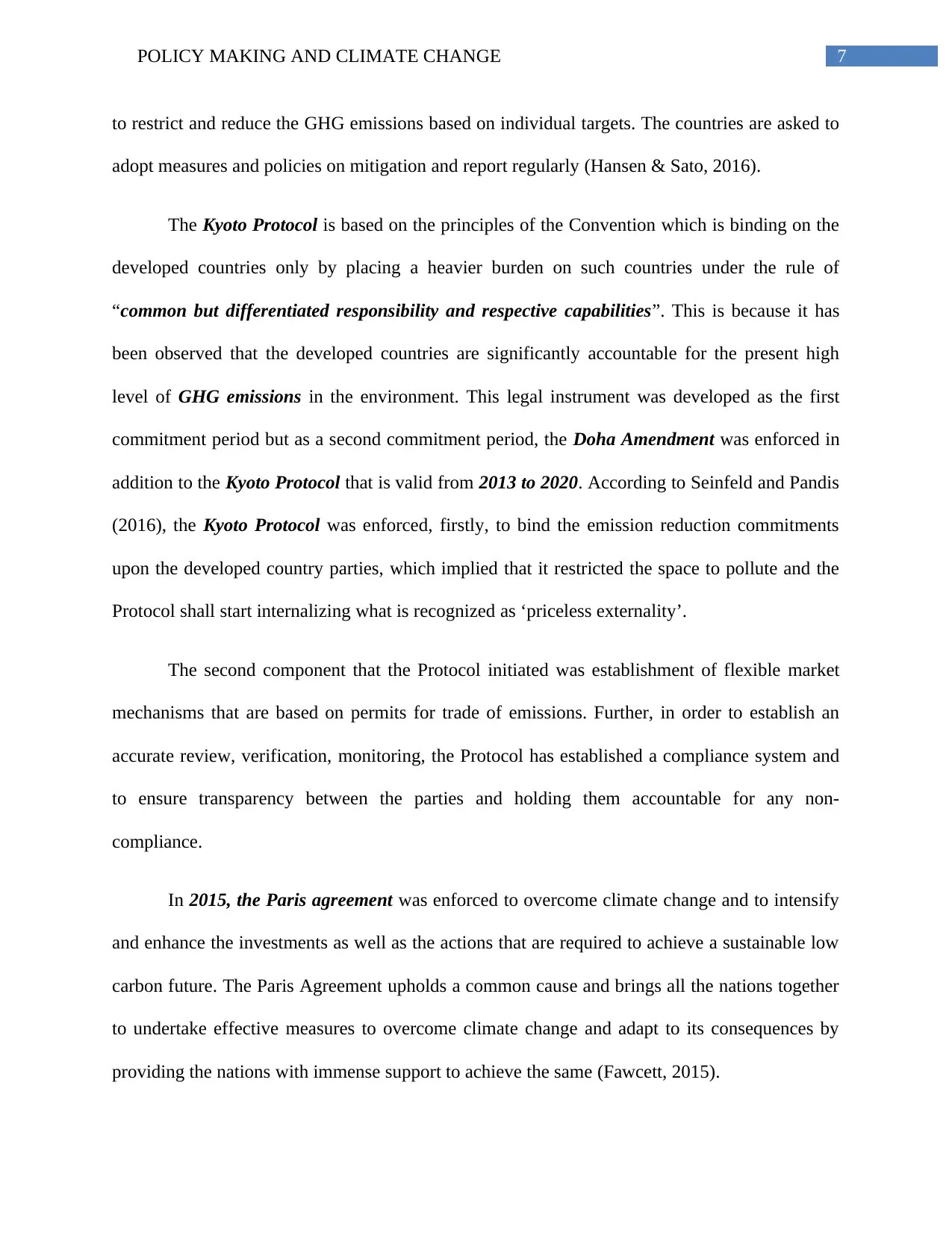
7POLICY MAKING AND CLIMATE CHANGE
to restrict and reduce the GHG emissions based on individual targets. The countries are asked to
adopt measures and policies on mitigation and report regularly (Hansen & Sato, 2016).
The Kyoto Protocol is based on the principles of the Convention which is binding on the
developed countries only by placing a heavier burden on such countries under the rule of
“common but differentiated responsibility and respective capabilities”. This is because it has
been observed that the developed countries are significantly accountable for the present high
level of GHG emissions in the environment. This legal instrument was developed as the first
commitment period but as a second commitment period, the Doha Amendment was enforced in
addition to the Kyoto Protocol that is valid from 2013 to 2020. According to Seinfeld and Pandis
(2016), the Kyoto Protocol was enforced, firstly, to bind the emission reduction commitments
upon the developed country parties, which implied that it restricted the space to pollute and the
Protocol shall start internalizing what is recognized as ‘priceless externality’.
The second component that the Protocol initiated was establishment of flexible market
mechanisms that are based on permits for trade of emissions. Further, in order to establish an
accurate review, verification, monitoring, the Protocol has established a compliance system and
to ensure transparency between the parties and holding them accountable for any non-
compliance.
In 2015, the Paris agreement was enforced to overcome climate change and to intensify
and enhance the investments as well as the actions that are required to achieve a sustainable low
carbon future. The Paris Agreement upholds a common cause and brings all the nations together
to undertake effective measures to overcome climate change and adapt to its consequences by
providing the nations with immense support to achieve the same (Fawcett, 2015).
to restrict and reduce the GHG emissions based on individual targets. The countries are asked to
adopt measures and policies on mitigation and report regularly (Hansen & Sato, 2016).
The Kyoto Protocol is based on the principles of the Convention which is binding on the
developed countries only by placing a heavier burden on such countries under the rule of
“common but differentiated responsibility and respective capabilities”. This is because it has
been observed that the developed countries are significantly accountable for the present high
level of GHG emissions in the environment. This legal instrument was developed as the first
commitment period but as a second commitment period, the Doha Amendment was enforced in
addition to the Kyoto Protocol that is valid from 2013 to 2020. According to Seinfeld and Pandis
(2016), the Kyoto Protocol was enforced, firstly, to bind the emission reduction commitments
upon the developed country parties, which implied that it restricted the space to pollute and the
Protocol shall start internalizing what is recognized as ‘priceless externality’.
The second component that the Protocol initiated was establishment of flexible market
mechanisms that are based on permits for trade of emissions. Further, in order to establish an
accurate review, verification, monitoring, the Protocol has established a compliance system and
to ensure transparency between the parties and holding them accountable for any non-
compliance.
In 2015, the Paris agreement was enforced to overcome climate change and to intensify
and enhance the investments as well as the actions that are required to achieve a sustainable low
carbon future. The Paris Agreement upholds a common cause and brings all the nations together
to undertake effective measures to overcome climate change and adapt to its consequences by
providing the nations with immense support to achieve the same (Fawcett, 2015).
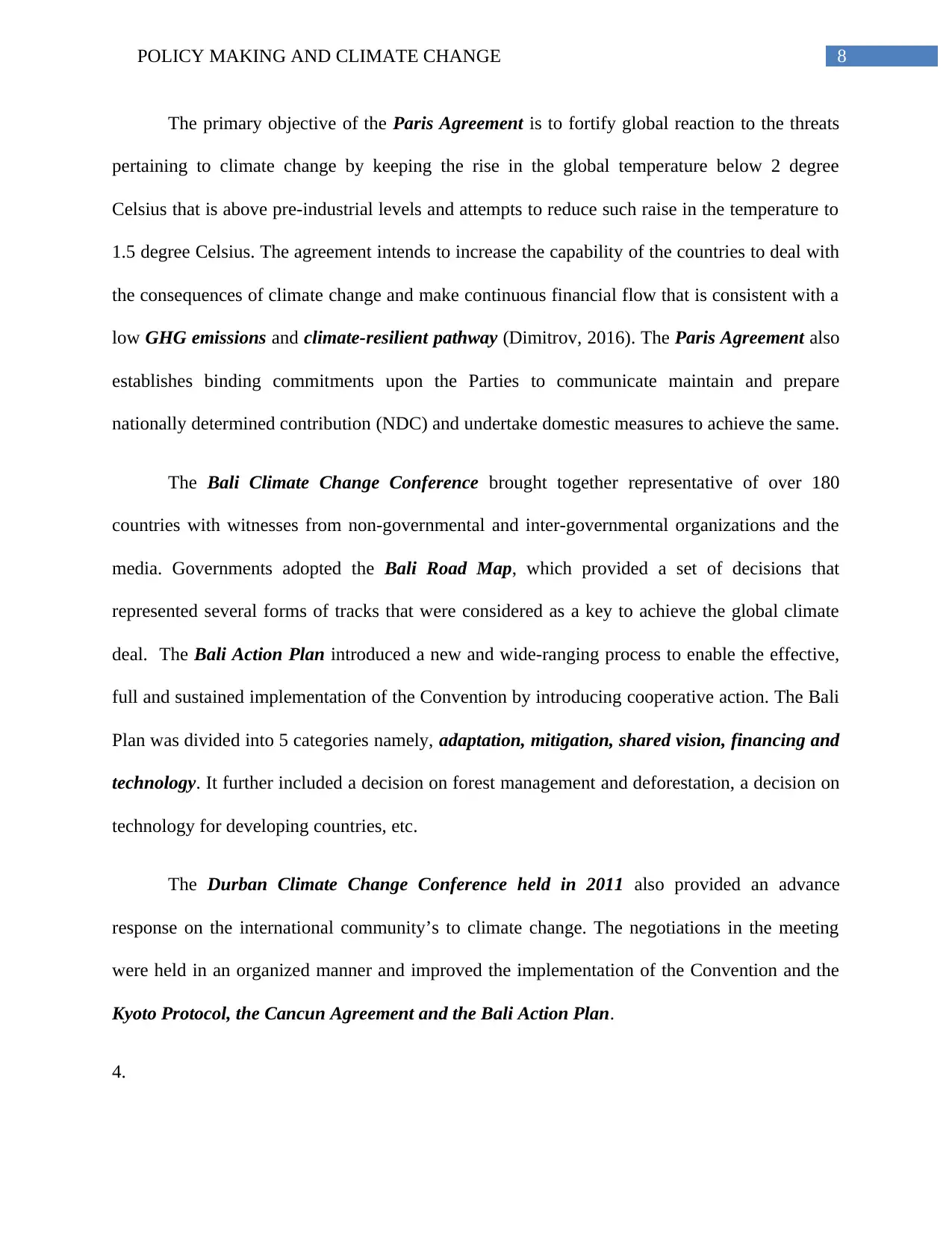
8POLICY MAKING AND CLIMATE CHANGE
The primary objective of the Paris Agreement is to fortify global reaction to the threats
pertaining to climate change by keeping the rise in the global temperature below 2 degree
Celsius that is above pre-industrial levels and attempts to reduce such raise in the temperature to
1.5 degree Celsius. The agreement intends to increase the capability of the countries to deal with
the consequences of climate change and make continuous financial flow that is consistent with a
low GHG emissions and climate-resilient pathway (Dimitrov, 2016). The Paris Agreement also
establishes binding commitments upon the Parties to communicate maintain and prepare
nationally determined contribution (NDC) and undertake domestic measures to achieve the same.
The Bali Climate Change Conference brought together representative of over 180
countries with witnesses from non-governmental and inter-governmental organizations and the
media. Governments adopted the Bali Road Map, which provided a set of decisions that
represented several forms of tracks that were considered as a key to achieve the global climate
deal. The Bali Action Plan introduced a new and wide-ranging process to enable the effective,
full and sustained implementation of the Convention by introducing cooperative action. The Bali
Plan was divided into 5 categories namely, adaptation, mitigation, shared vision, financing and
technology. It further included a decision on forest management and deforestation, a decision on
technology for developing countries, etc.
The Durban Climate Change Conference held in 2011 also provided an advance
response on the international community’s to climate change. The negotiations in the meeting
were held in an organized manner and improved the implementation of the Convention and the
Kyoto Protocol, the Cancun Agreement and the Bali Action Plan.
4.
The primary objective of the Paris Agreement is to fortify global reaction to the threats
pertaining to climate change by keeping the rise in the global temperature below 2 degree
Celsius that is above pre-industrial levels and attempts to reduce such raise in the temperature to
1.5 degree Celsius. The agreement intends to increase the capability of the countries to deal with
the consequences of climate change and make continuous financial flow that is consistent with a
low GHG emissions and climate-resilient pathway (Dimitrov, 2016). The Paris Agreement also
establishes binding commitments upon the Parties to communicate maintain and prepare
nationally determined contribution (NDC) and undertake domestic measures to achieve the same.
The Bali Climate Change Conference brought together representative of over 180
countries with witnesses from non-governmental and inter-governmental organizations and the
media. Governments adopted the Bali Road Map, which provided a set of decisions that
represented several forms of tracks that were considered as a key to achieve the global climate
deal. The Bali Action Plan introduced a new and wide-ranging process to enable the effective,
full and sustained implementation of the Convention by introducing cooperative action. The Bali
Plan was divided into 5 categories namely, adaptation, mitigation, shared vision, financing and
technology. It further included a decision on forest management and deforestation, a decision on
technology for developing countries, etc.
The Durban Climate Change Conference held in 2011 also provided an advance
response on the international community’s to climate change. The negotiations in the meeting
were held in an organized manner and improved the implementation of the Convention and the
Kyoto Protocol, the Cancun Agreement and the Bali Action Plan.
4.
⊘ This is a preview!⊘
Do you want full access?
Subscribe today to unlock all pages.

Trusted by 1+ million students worldwide
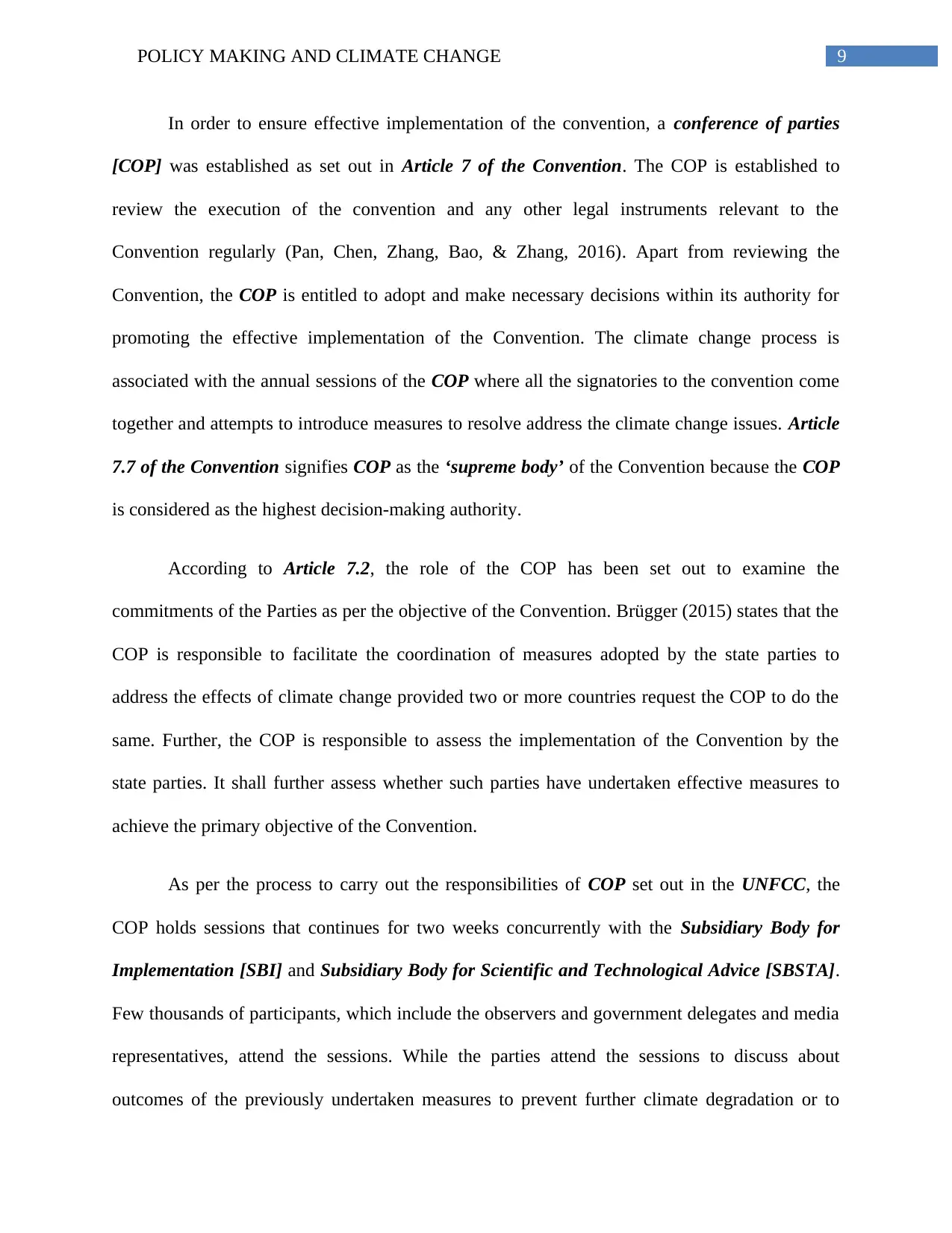
9POLICY MAKING AND CLIMATE CHANGE
In order to ensure effective implementation of the convention, a conference of parties
[COP] was established as set out in Article 7 of the Convention. The COP is established to
review the execution of the convention and any other legal instruments relevant to the
Convention regularly (Pan, Chen, Zhang, Bao, & Zhang, 2016). Apart from reviewing the
Convention, the COP is entitled to adopt and make necessary decisions within its authority for
promoting the effective implementation of the Convention. The climate change process is
associated with the annual sessions of the COP where all the signatories to the convention come
together and attempts to introduce measures to resolve address the climate change issues. Article
7.7 of the Convention signifies COP as the ‘supreme body’ of the Convention because the COP
is considered as the highest decision-making authority.
According to Article 7.2, the role of the COP has been set out to examine the
commitments of the Parties as per the objective of the Convention. Brügger (2015) states that the
COP is responsible to facilitate the coordination of measures adopted by the state parties to
address the effects of climate change provided two or more countries request the COP to do the
same. Further, the COP is responsible to assess the implementation of the Convention by the
state parties. It shall further assess whether such parties have undertaken effective measures to
achieve the primary objective of the Convention.
As per the process to carry out the responsibilities of COP set out in the UNFCC, the
COP holds sessions that continues for two weeks concurrently with the Subsidiary Body for
Implementation [SBI] and Subsidiary Body for Scientific and Technological Advice [SBSTA].
Few thousands of participants, which include the observers and government delegates and media
representatives, attend the sessions. While the parties attend the sessions to discuss about
outcomes of the previously undertaken measures to prevent further climate degradation or to
In order to ensure effective implementation of the convention, a conference of parties
[COP] was established as set out in Article 7 of the Convention. The COP is established to
review the execution of the convention and any other legal instruments relevant to the
Convention regularly (Pan, Chen, Zhang, Bao, & Zhang, 2016). Apart from reviewing the
Convention, the COP is entitled to adopt and make necessary decisions within its authority for
promoting the effective implementation of the Convention. The climate change process is
associated with the annual sessions of the COP where all the signatories to the convention come
together and attempts to introduce measures to resolve address the climate change issues. Article
7.7 of the Convention signifies COP as the ‘supreme body’ of the Convention because the COP
is considered as the highest decision-making authority.
According to Article 7.2, the role of the COP has been set out to examine the
commitments of the Parties as per the objective of the Convention. Brügger (2015) states that the
COP is responsible to facilitate the coordination of measures adopted by the state parties to
address the effects of climate change provided two or more countries request the COP to do the
same. Further, the COP is responsible to assess the implementation of the Convention by the
state parties. It shall further assess whether such parties have undertaken effective measures to
achieve the primary objective of the Convention.
As per the process to carry out the responsibilities of COP set out in the UNFCC, the
COP holds sessions that continues for two weeks concurrently with the Subsidiary Body for
Implementation [SBI] and Subsidiary Body for Scientific and Technological Advice [SBSTA].
Few thousands of participants, which include the observers and government delegates and media
representatives, attend the sessions. While the parties attend the sessions to discuss about
outcomes of the previously undertaken measures to prevent further climate degradation or to
Paraphrase This Document
Need a fresh take? Get an instant paraphrase of this document with our AI Paraphraser
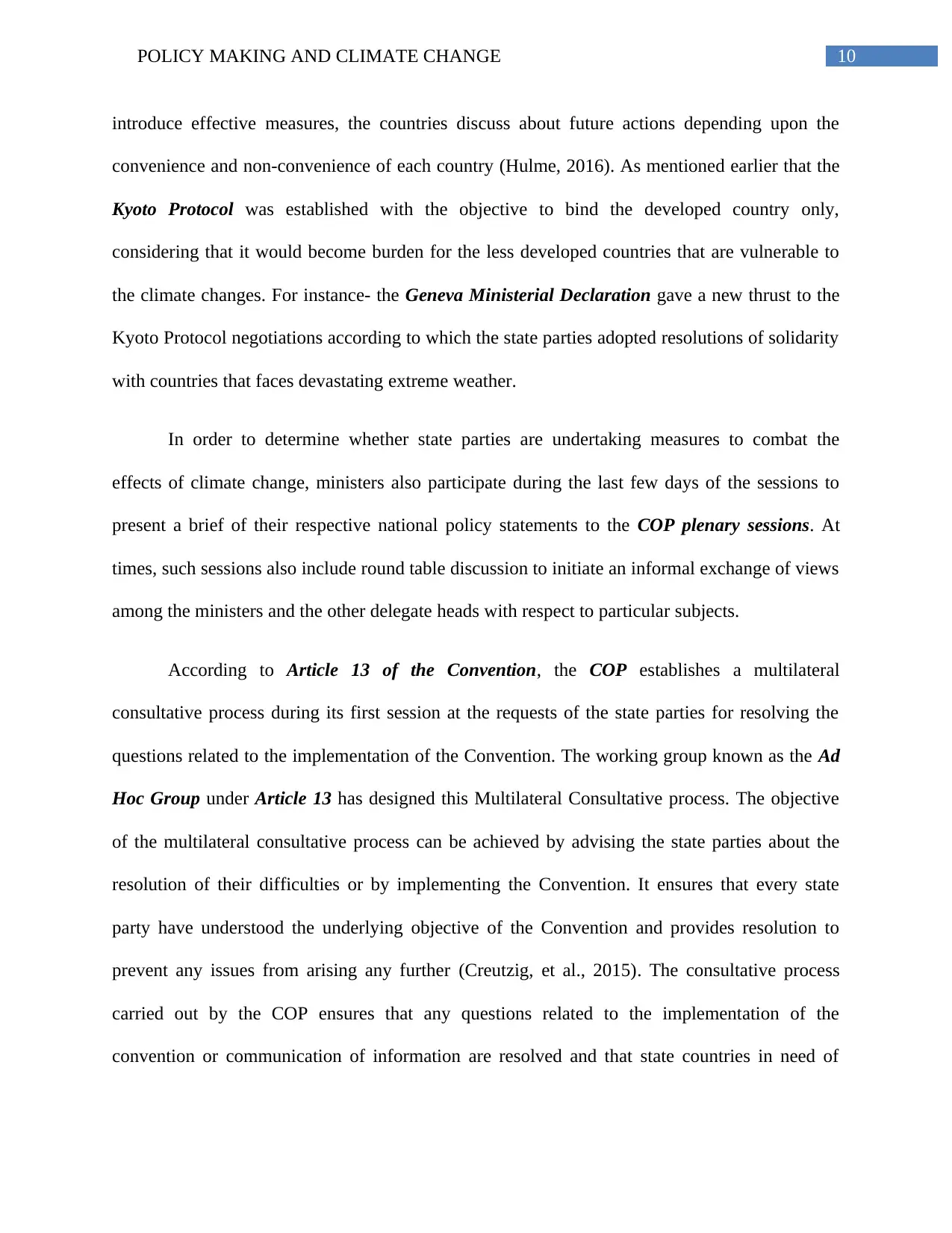
10POLICY MAKING AND CLIMATE CHANGE
introduce effective measures, the countries discuss about future actions depending upon the
convenience and non-convenience of each country (Hulme, 2016). As mentioned earlier that the
Kyoto Protocol was established with the objective to bind the developed country only,
considering that it would become burden for the less developed countries that are vulnerable to
the climate changes. For instance- the Geneva Ministerial Declaration gave a new thrust to the
Kyoto Protocol negotiations according to which the state parties adopted resolutions of solidarity
with countries that faces devastating extreme weather.
In order to determine whether state parties are undertaking measures to combat the
effects of climate change, ministers also participate during the last few days of the sessions to
present a brief of their respective national policy statements to the COP plenary sessions. At
times, such sessions also include round table discussion to initiate an informal exchange of views
among the ministers and the other delegate heads with respect to particular subjects.
According to Article 13 of the Convention, the COP establishes a multilateral
consultative process during its first session at the requests of the state parties for resolving the
questions related to the implementation of the Convention. The working group known as the Ad
Hoc Group under Article 13 has designed this Multilateral Consultative process. The objective
of the multilateral consultative process can be achieved by advising the state parties about the
resolution of their difficulties or by implementing the Convention. It ensures that every state
party have understood the underlying objective of the Convention and provides resolution to
prevent any issues from arising any further (Creutzig, et al., 2015). The consultative process
carried out by the COP ensures that any questions related to the implementation of the
convention or communication of information are resolved and that state countries in need of
introduce effective measures, the countries discuss about future actions depending upon the
convenience and non-convenience of each country (Hulme, 2016). As mentioned earlier that the
Kyoto Protocol was established with the objective to bind the developed country only,
considering that it would become burden for the less developed countries that are vulnerable to
the climate changes. For instance- the Geneva Ministerial Declaration gave a new thrust to the
Kyoto Protocol negotiations according to which the state parties adopted resolutions of solidarity
with countries that faces devastating extreme weather.
In order to determine whether state parties are undertaking measures to combat the
effects of climate change, ministers also participate during the last few days of the sessions to
present a brief of their respective national policy statements to the COP plenary sessions. At
times, such sessions also include round table discussion to initiate an informal exchange of views
among the ministers and the other delegate heads with respect to particular subjects.
According to Article 13 of the Convention, the COP establishes a multilateral
consultative process during its first session at the requests of the state parties for resolving the
questions related to the implementation of the Convention. The working group known as the Ad
Hoc Group under Article 13 has designed this Multilateral Consultative process. The objective
of the multilateral consultative process can be achieved by advising the state parties about the
resolution of their difficulties or by implementing the Convention. It ensures that every state
party have understood the underlying objective of the Convention and provides resolution to
prevent any issues from arising any further (Creutzig, et al., 2015). The consultative process
carried out by the COP ensures that any questions related to the implementation of the
convention or communication of information are resolved and that state countries in need of
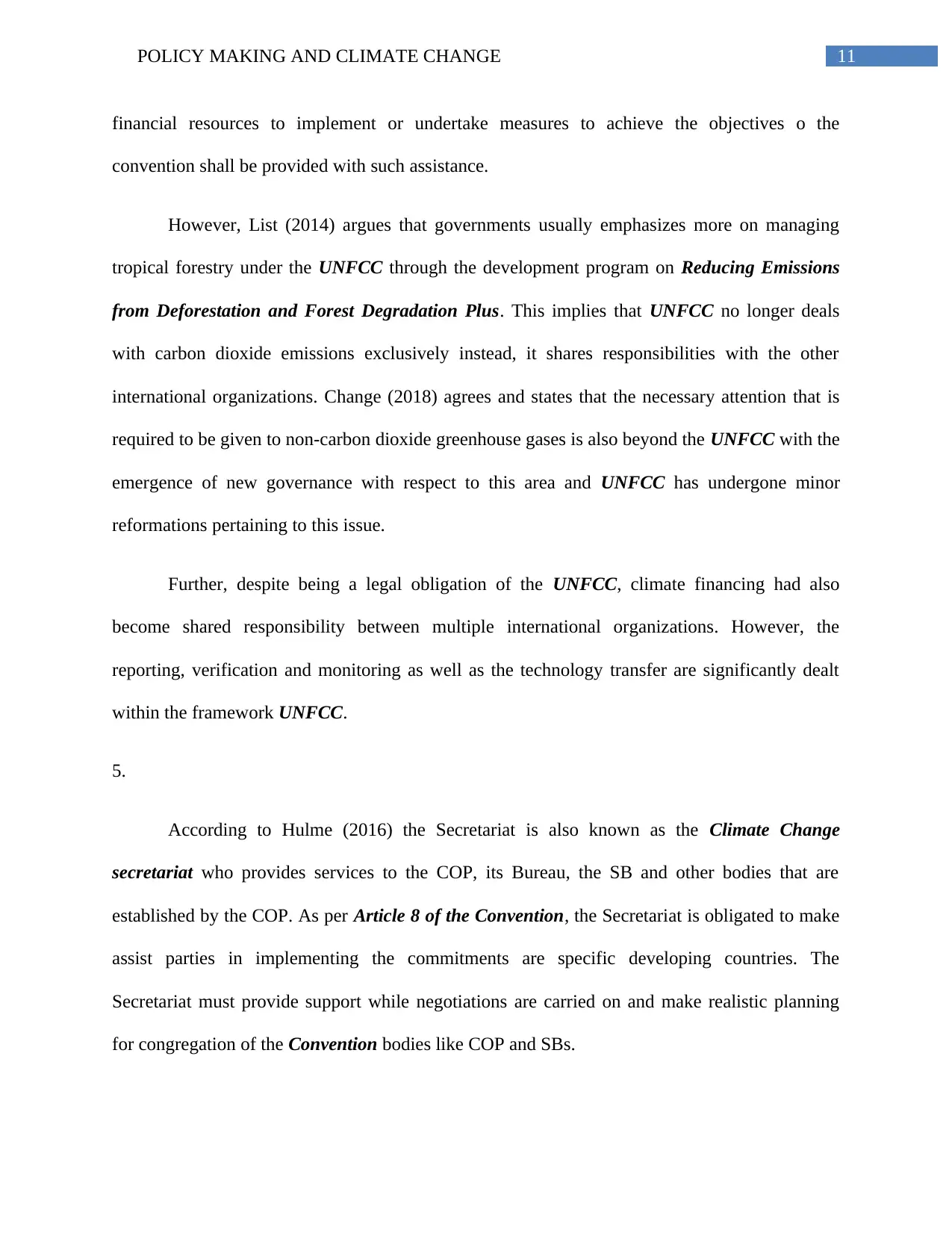
11POLICY MAKING AND CLIMATE CHANGE
financial resources to implement or undertake measures to achieve the objectives o the
convention shall be provided with such assistance.
However, List (2014) argues that governments usually emphasizes more on managing
tropical forestry under the UNFCC through the development program on Reducing Emissions
from Deforestation and Forest Degradation Plus. This implies that UNFCC no longer deals
with carbon dioxide emissions exclusively instead, it shares responsibilities with the other
international organizations. Change (2018) agrees and states that the necessary attention that is
required to be given to non-carbon dioxide greenhouse gases is also beyond the UNFCC with the
emergence of new governance with respect to this area and UNFCC has undergone minor
reformations pertaining to this issue.
Further, despite being a legal obligation of the UNFCC, climate financing had also
become shared responsibility between multiple international organizations. However, the
reporting, verification and monitoring as well as the technology transfer are significantly dealt
within the framework UNFCC.
5.
According to Hulme (2016) the Secretariat is also known as the Climate Change
secretariat who provides services to the COP, its Bureau, the SB and other bodies that are
established by the COP. As per Article 8 of the Convention, the Secretariat is obligated to make
assist parties in implementing the commitments are specific developing countries. The
Secretariat must provide support while negotiations are carried on and make realistic planning
for congregation of the Convention bodies like COP and SBs.
financial resources to implement or undertake measures to achieve the objectives o the
convention shall be provided with such assistance.
However, List (2014) argues that governments usually emphasizes more on managing
tropical forestry under the UNFCC through the development program on Reducing Emissions
from Deforestation and Forest Degradation Plus. This implies that UNFCC no longer deals
with carbon dioxide emissions exclusively instead, it shares responsibilities with the other
international organizations. Change (2018) agrees and states that the necessary attention that is
required to be given to non-carbon dioxide greenhouse gases is also beyond the UNFCC with the
emergence of new governance with respect to this area and UNFCC has undergone minor
reformations pertaining to this issue.
Further, despite being a legal obligation of the UNFCC, climate financing had also
become shared responsibility between multiple international organizations. However, the
reporting, verification and monitoring as well as the technology transfer are significantly dealt
within the framework UNFCC.
5.
According to Hulme (2016) the Secretariat is also known as the Climate Change
secretariat who provides services to the COP, its Bureau, the SB and other bodies that are
established by the COP. As per Article 8 of the Convention, the Secretariat is obligated to make
assist parties in implementing the commitments are specific developing countries. The
Secretariat must provide support while negotiations are carried on and make realistic planning
for congregation of the Convention bodies like COP and SBs.
⊘ This is a preview!⊘
Do you want full access?
Subscribe today to unlock all pages.

Trusted by 1+ million students worldwide
1 out of 18
Related Documents
Your All-in-One AI-Powered Toolkit for Academic Success.
+13062052269
info@desklib.com
Available 24*7 on WhatsApp / Email
![[object Object]](/_next/static/media/star-bottom.7253800d.svg)
Unlock your academic potential
Copyright © 2020–2025 A2Z Services. All Rights Reserved. Developed and managed by ZUCOL.




